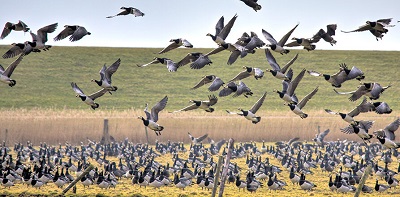Avian influenza: the largest epidemic in Europe in 2021-2022
The 2021-2022 epidemic of highly pathogenic avian influenza (HPAI) is the largest yet in Europe. The data are contained in the joint report EFSA, ECDC and the European Reference Laboratory (EURL) for avian influenza of the Istituto Zooprofilattico Sperimentale delle Venezie (IZSVe): 2,467 outbreaks in poultry, 48 million birds killed in the affected establishments, 187 surveys in captive birds and 3,573 HPAI events in wild birds. The geographical extent of the epidemic is also unprecedented: from the Svalbard islands to southern Portugal and east to Ukraine, affecting 37 European countries.
Only in the last three months, between June and September 2022, an unprecedented number of cases of Highly Pathogenic Avian Influenza (HPAI) infection in wild and domestic birds have been reported in Europe, as reported in the official EFSA press:
“Between 11 June and 9 September 2022,788 cases of HPAI were recorded in 16 EU/EEA countries and in the United Kingdom: poultry (56), captive birds (22) and wild birds (710). The unusual persistence in wild birds continued throughout the summer in 15 European countries. The virus has reached the breeding colonies of seabirds on the northern Atlantic and North Sea coasts, causing massive mortality, particularly in Germany, France, the Netherlands and the United Kingdom."
At the same time, a joint report was published on testing for zoonotic influenza virus infections in humans and on occupational safety measures for exposed workers. The document aims to provide guidance on how to promptly identify human infections transmitted by animal influenza viruses, in order to provide a rapid alert and implement the necessary prevention and control measures. It also describes the obligations of employers for the protection of workers from infection or in the event of outbreaks.
Dr. Calogero Terregino, director of the European Reference Laboratory for Avian Influenza at IZSVe, says that "despite the exceptional situation that has occurred in Europe, at the moment the risk of spillover of an avian influenza virus from animals to humans is low, but the situation needs to be constantly monitored because the virus is widespread and can evolve in a negative way at any time".
Zoonotic animal influenza viruses, mainly avian and swine influenza, can be transmitted from animals to humans and cause epidemics or even pandemics, as has already happened in the past. The people most exposed to spillover events are those at the forefront of outbreaks: breeders of species susceptible to influenza viruses, staff in zoos and slaughterhouses, laboratories, health facilities and personnel involved in the management of zootechnical waste or wildlife conservation.
Report EFSA/ECDC/EURL June-September 2022
Source: IZSVe
© IZSAM October 2022
|
|
Istituto Zooprofilattico Sperimentale
dell'Abruzzo e del Molise "G. Caporale"
Campo Boario | 64100 TERAMO | ITALIA
Telefono 0039.0861.3321 | Fax 0039.0861.332251
e-mail: archivioeprotocollo@izs.it
Posta elettronica certificata: protocollo@pec.izs.it
Partita IVA: 00060330677
Codice Fiscale: 80006470670



